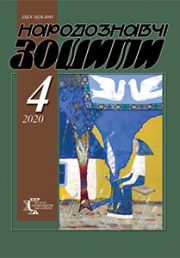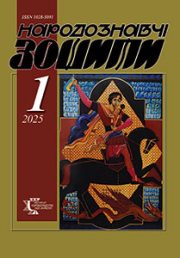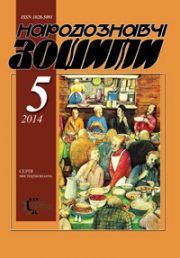2020 #4 Zhyshkovych V.
The Ethnology Notebooks. 2020. № 4 (154), 819—840
UDK 75.046(477)”17/18”Боровиковський В.
DOI https://doi.org/10.15407/nz2020.04.819
ZHYSHKOVYCH Volodymyr
- ORCID ID: https://orcid.org/0000-0003-2699-4907
- Ph.D., Senior Researcher
- of the Institute of Ethnology
- of the National Academy of Sciences of Ukraine,
- Department of Art Studies,
- 15, Svobody Avenue, 79000, Lviv, Ukraine,
- Contacts: е-mail: zhyshko@i.ua
Abstract. Introduction. The article deals with the Ukrainian artist Volodymyr Borovyk (better known as Volodymyr Borovykovskyj) creative achievements in the religious painting. The figure of the world-famous Ukrainian artist given his fruitful creative period during his stay in the capital of the Russian Empire — St. Petersburg was actively covered by Russian researchers and relatively modestly by Ukrainian ones. Mainly most of them spoke about Borovikovskyj as a high-level portrait-painter, one of the Russian Empire prominent artists in the portrait genre. The less attention received to artist’s religious painting. Especially in the context of his Ukrainian ancestry his icon painting was poorly explained. The need to focus on the Ukrainian origin of the phenomenon of Volodymyr Borovyk — Borovykovskyj activity in general, and his religious painting in particular determines the relevance of the proposed research.
Problem Statement. The purpose of the article is to distinguish the inherent features of the artist’s art, artistic and plastic features, to reveal the phased appearance of the works created by him. The article will outline the main topics and means of expressing in religious painting by Volodymyr Borovyk — Borovykovskyj. The aim is to determine its role in shaping innovative trends in Ukrainian church and pan-European religious painting in the second half of the 18th — early 19th centuries. The object of the study is the iconographic heritage of Volodymyr Borovyk — Borovykovskyj; the subject of research is the peculiarities of the evolution of his creative manner, as one of the important factors in the formation of innovative tendencies in the religious painting of the pan-European artistic space. The article uses the methods of iconographic, iconological and formal analysis, as well as the methods of semiotic analysis and the method of historical and cultural research.
Results. In the article the basic stages of Volodymyr Borovyk — Borovykovskyj’s creativity are traced by the method of comparative analysis of stylistic features of artistic manner. The main focus is on the study of his work during his stay in Ukraine. In addition, the paintings created by the artist outside the homeland for the iconostasis of the Church of the Intercession of the Blessed Virgin Mary in the Ukrainian village of Romanivka in Chernihiv are analyzed. The main topics and means of expressiveness of the artist in the works on the religious theme are outlined.
Conclusion. Volodymyr Borovyk — Borovykovskyj, having reached the pinnacle in the genre of portraiture, has never abandoned religious subjects in his work. Having been brought up on the traditions of Ukrainian church painting in the Cossack Baroque period, Volodymyr Borovyk — Borovykovskyj quickly understood the artistic and plastic foundations of contemporary European art and brought the religious painting to a new vision, depth of knowledge of the divine. In the late 18th — early 19th centuries Ukrainian Volodymyr Borovyk — Borovykovsky became one of the cohort of the most famous artists of the Russian Empire who worked in the area of church painting.
Keywords: church, iconostasis, painting, iconography, style, artistic features, Volodymyr Borovyk — Borovykovskyj.
Received 4.05.2020
REFERENCES
- Paul of Aleppo (Archdeacon). (1897). The journey of the Antioch Patriarch Makaria to Russia in the half of the 17th century, described by his son, Archdeacon Paul of Aleppo (Issue 2). Moscow: University printing house [in Russian].
- Kondakov, S.N. (Ed.). (1915). Borovikovskiy, Vladimіr Lukich. Anniversary Directory of the Imperial Academy of Arts. 1764—1914 (In 2 vol.) (Part II, pp. 21—22). Petrograd: Imperial St. Petersburg Academy of Arts; Association of R. Golike and A. Wilborg [in Russian].
- Bazhan, M.P., & Afanasiev, V.A. (Eds.). (1973). Borovikovskiy Vladimіr Lukich. Dictionary of Artists of Ukraine (P. 33). Kyiv: The main edition of the Ukrainian Soviet Encyclopedia [in Ukrainian].
- Alekseeva, T.V. (1975). Vladimir Lucic Borovikovsky and the Russian culture a turn of the 18th—19th century. Moscow: Art [in Russian]
- Khanko, V.M. (no year). Borovikovski Volodimir Lukich (Borovikivski). Poltavika. Poltava encyclopedia. Retrieved from: http://history-poltava.org.ua/?p=1063 (Last accessed: 08.01.2020) [in Ukrainian].
- Gorlenko, V. (1908). Borovikovsky, Vladimir Lukich. Russian biographical dictionary: Betancourt — Biacster. Published under the supervision of the Chairman of the Imperial Russian Historical Society A.A. Polovtsov (Vol. 3, pp. 253—263). St. Petersburg: printing house of the General Administration [in Russian].
- Kudrytsky, A.V. (Ed.). (1992). Borovykovski. Artists of Ukraine: Encyclopedic Reference Book (P. 85). Kyiv: Ukrainian Encyclopedia [in Ukrainian].
- Khanko, V.M. (no year). Borovyky. Poltavika. Poltava Encyclopedia. Retrieved from: http://history-poltava.org.ua/?p=1058 (Last accessed: 08.01.2020) [in Ukrainian].
- Zholtovskyi, P.M. (1983). Artistic life in Ukraine in the 16th—18th centuries. Kyiv: Naukova dumka [in Ukrainian].
- «Mary, mother of Jesus» by Luka Borovyk, 1771. From Wikipedia, the free encyclopedia. Retrieved from: https://en.wikipedia.org/wiki/File: «Mary,_mother_of_Jesus»_by_Luka_Borovyk,_1771.jpg (Last accessed: 08.01.2020).
- Rozsokha, L. (2002). Figures and shadows. Borovyky, Borovychenky, Borovykivski. In Rozsokha, L. Myrgorod Antiquity: Research. Articles. Essays. Investigations. Kobeliaky: «Kobeliaky» Publishing House. Retrieved from: http://slavia.do.am/Biblioteka/rozsokha_l-mirgorodska_starovina.pdf (Last accessed: 08.01.2020) [in Ukrainian].
- Chlenova, L. (Ed.). (2005). Ukrainian icon painting of 12th—19th centuries from the National Art Museum of Ukraine collection: album. Khmelnytskyi: Gallery; Kyiv: Artaniia Nova [in Ukrainian].
- Zholtovskyi, P.M., & Yurchenko, P.H. (Ed.). (1968). Iconpainting. In P.H. Yurchenko. History of Ukrainian Art: in 6 vol. Art of the second half of 17th—18th centuries (Vol. 3, pp. 193—240). Kyiv: Zhovten’ [in Ukrainian].
- Bocharova, S.I. (Ed.). (2009). Poltava Art Museum (Art Gallery) of Mykola Yaroshenko. Album. Anniversary Edition. Poltava: Physical person businessman Hovorov S.V. [in Ukrainian].
- Chukin, D.V. (1931). Borovykovskyi. In Berezynskyi, A. (Ed.). Borovykovskyi: Album. Series: Ukrainian Painting (Pp. 5—19). Kharkiv: Rukh [in Ukrainian]
- Tarasenko, I.Yu. (2012). Correspondence of Pavlo Zholtovskyi. Kyiv: M.S. Grushevskyi institute of Ukrainian Archeography and Source Studies of the National Academy of Sciences of Ukraine [in Ukrainian].
- Petrova, E. (Ed.). (1998). Painting. 18th century. The State Russian Museum. General Catalogue of the Museum Collection: in 15 vol. (Vol. 1). St. Petersburg: Palace Editions [in Russian].
- Stolbova, E., Maksimova, A., & Laks, A. (Ed.). (2009). Vladimir Lukich Borovikovsky: religious painting. Exhibition catalogue album at the State Russian Museum. St. Petersburg: Palace Editions [in Russian].
- Grech, A.N. (1927). Arpachevo. Collection of the Society for the Study of the Russian Estate (Vol. 2, pp. 9—16). Moscow: OIRU [in Russian].
- Markina, L. (2007). Borovikovsky saved beauty. Nashe Nasledie. The illustrated cultural and historical magazine, 81. Retrieved from: http://www.nasledie-rus.ru/podshivka/8102.php (Last accessed: 06.01.2020) [in Russian].
- Markina, L.A. (Ed.). (2008). «…The beauty of her saved by Borovikovsky»: Vladimir Lukich Borovikovsky. 1757—1825. To the 250th anniversary of the artist’s birth. Catalogue of the exhibition in the State Tretyakov Gallery. Moscow: M-Skanrus [in Russian].
- Komashko, N.I. (2006). Russian icon of the 18th century. Moscow: Agei Tomesh [in Russian].
- Grishanova, L. (2017, February 9). Cathedral of St. Joseph: A «Pearl» of history. Mohylevskaia Pravda. Retrieved from: https://mogpravda.by/ru/issues?art_id=4660 (Last accessed: 10.01.2020) [in Russian].
- Bruk, Ya.V., & Iovleva, L.I. (Eds.). (1998). Painting of the 18th century. State Tretyakov gallery. Meeting catalog: in 4 series (Vol. 2). Moscow: Krasnaia ploschad’ [in Russian].
- Kazan Cathedral. Architecture, painting, sculpture. Retrieved from: http://kazansky-spb.ru/texts/architecture (Last accessed: 11.01.2020) [in Russian].
- «Iconostasis of Borovikovsky brush». The patron and benefactor — Stepan Artemievich Lashkevich. Chernihiv province. Mglynskyi region. Retrieved from: http://www.mglin-krai.ru/chernigovskaya-guberniya/350-metsenat-i-blagotvoritel-stepan-artemevich-lashkevich (Last accessed: 11.01.2020) [in Russian].
- Gornostayev, F.F. (1914). Palaces and Churches of the South. Cultural treasures of Russia (Vol. 8.). Moscow: Publishing house association «Obrazovanie» [in Russian].
- Gornostayev, F.F., Uvarova, Countess (Ed.). (1911). Iconostas of V.L. Borovikovsky brush with 10 tables. In Works of the Fourteenth Archaeological Congress in Chernihiv. 1908. (Vol. 2, pp. 213—218). Moscow: Printing house G. Lissner and D. Sobko [in Russian].
- Iconostasis of Romanovsky church. Retrieved from: http://old.mglin-krai.ru/Muzei/Ikonostas-2.htm (Last accessed: 13.01.2020) [in Russian].
- Gorlenko, V. P. (1891). Painter V.L. Borovikovsky: Biographical Essay. Russian archive. Historical and literary collection (Vol. 6, pp. 257—291). Moscow: University printing house [in Russian].
- Silin, A., Kremer, A., & Silin, A. (Eds.). (2013). From the history of Tishanka. In The customs, beliefs and prejudices of the peasants of the village of Verkhotishanka of the Bobrovsky district of the Voronezh province (now the village is Tishanka of the Talovsky district). Voronezh: Nauchnaia kniga. Retrieved from: http://samlib.ru/s/silin_a_s/obichai.shtml (Last accessed: 13.01.2020) [in Russian].







